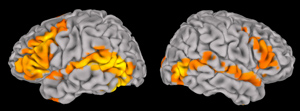
The study of signed languages provides a unique tool for investigating the functional neural organization of language in the human brain. We use functional magnetic resonance imaging (fMRI), structural MRI, and event-related potentials (ERPs) to address the following questions:
- Is the deaf, signing brain different from the hearing, speaking brain?
- What is the nature of the bimodal bilingual brain?
- Are there differences in brain anatomy between signers and speakers?
- How is sign perception different from action perception?
- How is language about space and motion processed by the brain?
- Does using a signed language impact the neural organization for non-linguistic visual processing?
Funding
This research is supported by the National Institute of Deafness and Other Communication Disorders (R01 DC101977 and R01 DC014246) and by the National Institute of Child Health and Human Development (R01 HD047736).
Recent Publications
- Emmorey, K. (2023). Ten Things You Should Know About Sign Languages. Current Directions in Psychological Science, 0(0). https://doi.org/10.1177/09637214231173071
- Banaszkiewicz, A., Bola, L., Matuszewski, J., Szczepanik, M., Kossowski, B., Mostowski, P., Rutkowski, P., Śliwińska. M., Jednoróg, K., Emmorey, K., & Marchewka, A. (2021). The role of the superior parietal lobule in lexical processing of sign language – insights from fMRI and TMS studies. Cortex, 135, 240-254. https://pubmed.ncbi.nlm.nih.gov/33401098/
- Banaszkiewicz, A., Matuszewski, J., Bola, L., Szczepanik, M., Kossowski, B., Rutkowski, P., Szwed, M., Emmorey, K., Jednoróg, K., & Marchewka, A. (2021). Multimodal imaging of brain reorganization in hearing late learners of sign language. Human Brain Mapping, 42, 384-397. https://pubmed.ncbi.nlm.nih.gov/33098616/
- Emmorey, K., Midgley, K.J., & Holcomb, P.J. (2021). Tracking the time course of sign recognition using ERP repetition priming. Psychophysiology, 59:e13975. https://pubmed.ncbi.nlm.nih.gov/34791683/
- Emmorey, K. (2021). New perspectives on the neurobiology of sign languages. Frontiers in Communication: Language Sciences. https://www.frontiersin.org/articles/10.3389/fcomm.2021.748430/full
- Emmorey, K., Brozdowski, C., & McCullough, S. (2021). The neural correlates for spatial language: Perspective-dependent and -independent relationships in American Sign Language and spoken English. Brain and Language, 223, 105044 https://www.sciencedirect.com/science/article/pii/S0093934X21001383?via%3Dihub
- McCullough, S., & Emmorey, K. (2021). Effects of deafness and sign language experience on the human brain: Voxel-based and surface-based morphometry. Language, Cognition and Neuroscience, 36(4), 422-439. https://pubmed.ncbi.nlm.nih.gov/33959670/
- Meade, G., Lee, B., Massa, N., Holcomb, P.J., Midgley, K.J., & Emmorey, K. (2021). The organization of the American Sign Language lexicon: Comparing one- and two-parameter ERP phonological priming effects across tasks. Brain and Language, https://pubmed.ncbi.nlm.nih.gov/33940343/
- Emmorey, K. (2020). Sign language: How the brain represents phonology without sound. Current Biology, 30, R1361-R1389. https://pubmed.ncbi.nlm.nih.gov/33202232/
- Emmorey, K., Winsler, K., Midgley, K.J., Grainger, J., & Holcomb, P.J. (2020). Neurophysiological correlates of frequency, concreteness, and iconicity in American Sign Language. Neurobiology of Language, 1(2), 249-267. PMCID: PMC pending https://www.mitpressjournals.org/doi/pdf/10.1162/nol_a_00012
- McGarry, M., Mott, M., Midgley, K.J., Holcomb, P.J., & Emmorey, K. (2020). Picture-naming in American Sign Language: an electrophysiological study of the effects of iconicity and structured alignment. Language, Cognition and Neuroscience. PMCID: PMC pending https://doi.org/10.1080/23273798.2020.1804601
Recent Presentations
- Emmorey, K. (2022). The signing brain: What sign languages can tell us about human language. William A. Danielson Award Lecture for Distinguished Contributions to Communication. University of Texas, Austin, April, Virtual talk.
- Terhune-Cotter,B., McCullough, S., & Emmorey, K. (2022). Comparing neural activation at the lexical, syntactic, and narrative levels in American Sign Language comprehension. Poster presented at the Cognitive Neuroscience Society Meeting, April, San Francisco, CA. (pdf)
- Emmorey, K. (2021). The signing brain: What sign languages can tell us about human language. Oxford Psychological Society. November, Virtual colloquium.
- Emmorey, K., Midgley, K., & Holcomb, P. (2021). Tracking the time course of sign recognition using ERP repetition priming. Poster slam presented at the Society for the Neurobiology of Language meeting, October, Virtual meeting.
- McCullough, S.M., & Emmorey, K. (2021). Cross-modal effects of pseudosign articulation (overt and covert) on the extrastriate cortex: an adaptation fMRI study. Poster slam presented at the Society for the Neurobiology of Language meeting, October, Virtual meeting.
- Terhune-Cotter, B., McCullough, S.M., & Emmorey, K. (2021). An fMRI localizer for American Sign Language comprehension (Sandbox Series). Poster slam presented at the Society for the Neurobiology of Language meeting, October, Virtual meeting.
- Emmorey, K.(2019) Neural and behavioral consequences of lexical iconicity in American Sign Language. Invited speaker for the meeting of Sign Language Linguistics Society (TISLR13). September, Hamburg, Germany.
- Emmorey, K. (2019). Neural effects of iconicity in sign language. Invited presentation at Neuroscience of Language Conference, April, Abu Dhabi, United Arab Emirates.
- Lee, B., Midgley, K.J., Holcomb, P.J., Emmorey, K., & Meade, G. (2019). ERP evidence for phonological priming in American Sign Language in a semantic task. Poster presented at the Cognitive Neuroscience Society, March, San Francisco. (pdf)
- McCullough, S., Brozdowski, C., & Emmorey, K. (2019). Neural correlates for comprehending perspective-independent and perspective-dependent spatial expressions in ASL and English. Poster presented at the Cognitive Neuroscience Society, March, San Francisco. (pdf)

